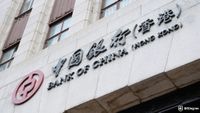The team behind Curve Finance claims that the dip experienced by crvUSD was relatively minor.
In the wake of recent exploitative events, Curve Finance's stablecoin, crvUSD, had a short-lived depegging from the US dollar on August 3rd.
The value of the stablecoin dipped by 0.35% over the day, hinting at an unsettling atmosphere around the protocol.

Did you know?
Want to get smarter & wealthier with crypto?
Subscribe - We publish new crypto explainer videos every week!
Crypto Mining Explained: How to Earn From Mining Bitcoin? (Animated)


Curve's crvUSD peg to the US dollar is controlled by the mechanism called the PegKeeper algorithm. PegKeeper is responsible for overseeing the stablecoin's interest rate and liquidation ratio, adjusting these factors in accordance with the supply and demand of crvUSD to retain its value.
Essentially, the PegKeeper algorithm acts as a counterbalance, ensuring that the value of crvUSD is appropriately supported by collateral while aligning supply and demand.
In an attempt to contextualize the temporary depeg of crvUSD, Curve Finance drew parallels between the Silicon Valley Bank collapse and the brief depegging of the USD Coin (USDC). The protocol pointed out that while there were similarities between these events, the dip experienced by crvUSD was relatively minor.
The depeg is a direct response to Curve Finance's July 30th exploit. The protocol fell victim due to a vulnerability in the Vyper programming language. The aftermath of this incident has led to widespread concern about its potential spillover effects on the decentralized finance (DeFi) ecosystem, resulting in a wave of panic across multiple protocols and a 20.91% decline in the value of its governance token, Curve DAO (CRV).
The recent hacking incident and the declining CRV price have sparked apprehensions within the crypto community about potential cascading effects on other protocols. Michael Egorov, founder of Curve Finance, had used his CRV holdings as collateral for a $100 million stablecoin loan. His ongoing efforts to reduce his loan position have become a focal point of these concerns.
However, on August 3rd, several DeFi projects, including Curve Finance, offered malicious actors a 10% bounty in return for stolen funds.
The recent disturbance around Curve Finance's crvUSD serves as a reminder of the vulnerabilities inherent in DeFi systems. It underscores the importance of strong, community-driven support in navigating these challenges and fostering the overall health and resilience of the ecosystem.






















